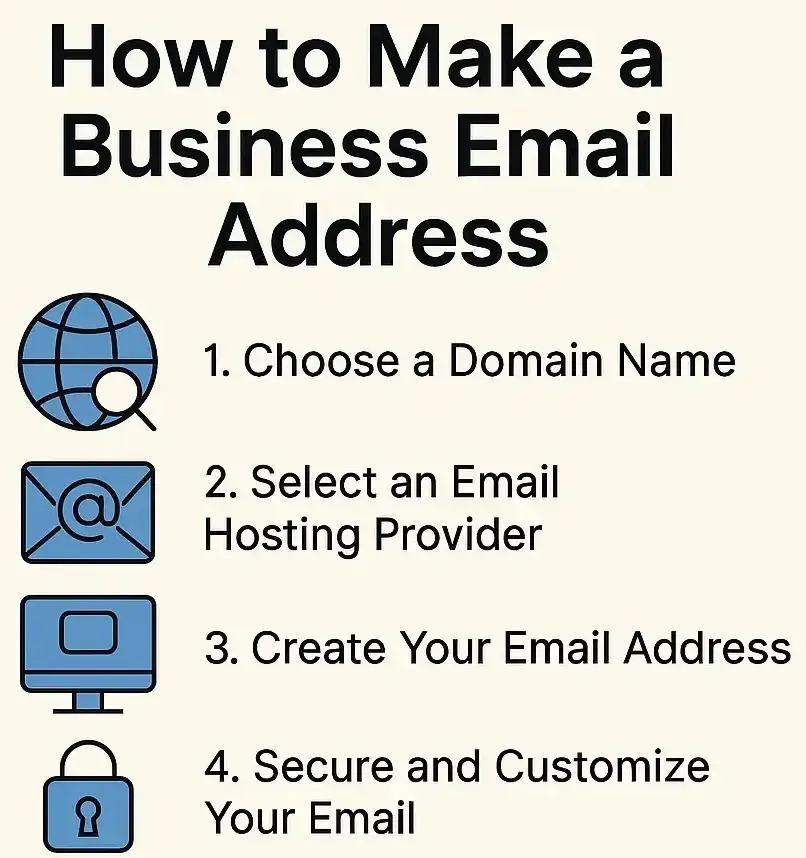Discover how to build a professional business email address using your domain. A complete guide for entrepreneurs, freelancers, and startups
how to make a business email address, create email with domain name, professional email for startup, business email setup guide, free business email without website.
Crafting a Business Email Address That Builds Trust and Brand Identity
How to Make a Business Email Address That Reflects Professionalism
In today’s digital-first world, your email address is more than just a communication tool—it’s a reflection of your brand. Whether you’re launching a startup, managing a freelance portfolio, or scaling a small business, having a custom business email address like hello@yourbrand.com sets the tone for credibility and trust.
🔍 Why a Custom Business Email Matters
- Brand Authority: A domain-based email reinforces your business identity and separates you from generic providers.
- Client Confidence: Customers are more likely to respond to support@yourcompany.com than yourcompany@gmail.com.
- Scalability: You can create multiple role-based addresses like billing@, press@, or team@.
- Deliverability: Emails from verified domains are less likely to be flagged as spam.
🛠️ Step 1: Secure a Domain Name That Represents Your Brand
Your domain is the backbone of your business email. It should be short, memorable, and aligned with your brand name. For example, if your business is called “EcoNest,” consider econest.com or econest.tech.
Recommended registrars:
- Namecheap – Affordable and beginner-friendly
- Google Domains – Seamless integration with Gmail
- GoDaddy – Popular with small businesses
Step 2: Choose an Email Hosting Provider
Once your domain is registered, you’ll need an email hosting service to manage your inbox. These platforms allow you to send and receive emails using your domain name.
- Google Workspace – Gmail interface with custom domain support
- Microsoft 365 Outlook – Ideal for businesses using Office tools
- Zoho Mail – Free plan available for up to 5 users
Look for features like spam protection, mobile access, and calendar integration.
Step 3: Connect Your Domain to Your Email Host
This step involves verifying your domain and updating DNS records. Your provider will guide you through adding:
- MX Records: Direct email traffic to your host
- SPF Records: Prevent spoofing and improve deliverability
- DKIM & DMARC: Authenticate your email and protect against phishing
Setup guides:
Step 4: Create Role-Based and Personal Email Accounts
Once your domain is connected, you can create email addresses tailored to your business needs:
- yourname@yourdomain.com – Personal use
- info@yourdomain.com – General inquiries
- support@yourdomain.com – Customer service
- sales@yourdomain.com – Lead generation
Use aliases or distribution groups to streamline communication across departments.
Step 5: Secure Your Business Email Environment
Protecting your email accounts is essential. Implement these best practices:
- Enable two-factor authentication (2FA)
- Use strong, unique passwords for each account
- Activate spam filters and virus scanning
- Regularly audit access permissions
Enterprise-grade platforms like Google Workspace and Microsoft 365 offer built-in security tools.
Step 6: Customize Your Email Branding
Make your emails visually consistent with your brand identity:
- Add your logo and contact info to your signature
- Use branded templates for newsletters and outreach
- Include disclaimers and legal notices if needed
Try tools like HubSpot’s Email Signature Generator to design a professional signature.
Bonus: Free Business Email Without a Website
If you’re just starting and don’t have a domain or hosting, platforms like Neo offer free business email addresses using subdomains like yourname@yourbrand.co.site.
This is ideal for freelancers or early-stage entrepreneurs who want a professional presence without upfront costs.
Final Thoughts
Creating a business email address isn’t just about sending messages—it’s about building trust, reinforcing your brand, and laying the foundation for professional communication. Whether you choose Gmail for business, Outlook, or Zoho, the key is consistency, security, and clarity.
For further reading, explore:
- [How to Create a Custom Email Address in 4 Steps – Fit Small Business](https://fitsmallbusiness.com/create-email-custom-address/)
- [20 Unique Email Address Ideas for 2025 – Spike](https://www.spikenow.com/blog/productivity/email-address-ideas/)
- [What Is a Unique Email Address – Clean Email](https://bing.com/search?q=how+to+make+a+business+email+address+unique+content)
tags
- How do I create a free business email address?
Which email is best for a small business?
Is info@ a good business email?
What qualifies as a business email address?
Free business email
Create free business email
Gmail business email login
Google business email
Create business email
Microsoft business email
Free business email without domain
Business email

